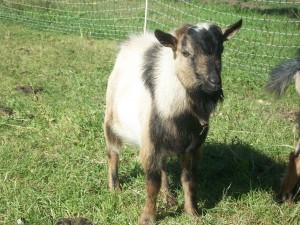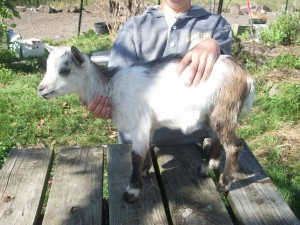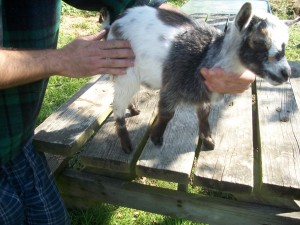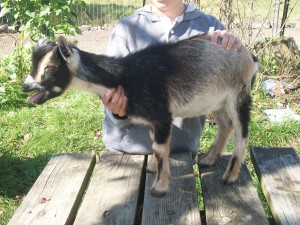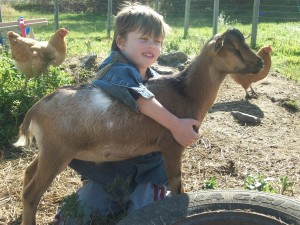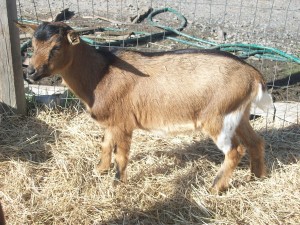The Read-Aloud List
Sharon October 18th, 2011
I will finish my 150 Children’s books list one of these days, but one of the great things to do when times are tough, nights are late, power is out or when everything’s normal for that matter, is read to your kids. If you don’t have any kids, I encourage you to borrow some if you can, because frankly, reading to children is one of the great pleasures of the universe. There’s nothing like reading an old favorite (or one you never knew about) and watching someone discover it for the first time to make you happy. If you don’t have any kids, reading aloud to a partner can be lovely as well, but a small person snuggled on your lap is nice addition.
With my oldest at 11 1/2, I have now read My Side of the Mountain, the entire Little House series 3 times (and will shortly embark on the fourth), Winnie the Pooh and the Mary Poppins Series four times. We’re still discovering new books to read and re-read, but I thought I’d mention some of the best, including a few less obvious ones than the classics above. I’ll also mention a few classics we’ve had less than total success with, although, of course, your mileage may vary.
Every kid in my house gets a story at bedtime (sometimes both of us reading simultaneously) most nights, and the range of preferences is pretty large. Isaiah likes animal stories and adventure, Simon likes everything, especially stories that seem real to him, Eli loves poetry and Asher jumps back and forth (at nearly six) between picture books and chapter books, and has a taste for magic and fantasy.
Good books and good read-alouds are different, I find. There is considerable overlap between them, of course, but some books that aren’t quite as compelling read to yourself are fabulous read-alouds if you hit them at the right moment in childhood, and some wonderful classics aren’t ideal read-alouds unless you do considerable on-the-fly editing. Different families will have different opinions, of course, but I find a few ingredients make books especially good for reading out loud. Many of them come from the virtue that for most of us, reading out loud slows you down, and forces you not to skim over anything. As a fast reader, what I find is that I am required to take full notice of parts of the book that I might not attend to fully were I not simultaneously reading (or listening to Eric read) and listening.
1. A certain kind of dry humor. There are some books that are simply funniest when you read the jokes out loud. My favorite example of this is _Cheaper by the Dozen_ where much of the humor involved is most effective when you hear it read - even the reader will find it funnier that way. _Three Men in a Boat_ which incredibly wonderful anyway, is another book where simply slowing down to read it out loud makes the comedy more effective.
2. High adventure of a certain sort - storms on boats, pirates, sword fights, horseback races, etc… all demand to be read aloud in minute and meticulous detail - every sword slash or adventure is detailed. For someone reading silently to themselves, it can be hard to fully savor every detail in the way you can when voices and description beg to be read outloud. _Treasure Island_, Howard Pyles _Adventures of Robin Hood_ and _The Hound of the Baskervilles_ are obvious examples, but this is, of course, one of the appeals of the Harry Potter books and books like _The Tale of Despereaux_ as well.
3. Certain kinds of style and language. There isn’t one kind of writing style that is suited to being read out loud to children - wonderful children’s books come in all sorts. At the same time, it is harder to hide weaknesses of style when reading aloud than reading to oneself. I know for example, that I wept at _Black Beauty_ as a girl. I made a stab at reading it out loud to my kids, however, and we were all bored stiff. Some children’s books substitute extensive description for good description, frankly. Particularly for younger children (or for everyone when it is well done) I’m partial to a certain unadorned quality in my language - just good, clean, elegant bare prose (of the kind I never write myself, sadly). Laura Ingalls Wilder (particularly in _Little House in the Big Woods_ which was the book of hers least amended by her daughter), Robert Heinlein (whose juvenalia like _Have Space Suit Will Travel_ makes for delightful read alouds) and Patricia MacLachlan are all very different practitioners of the art of producing amazingly clean prose for children. When the writing is more elaborate and stylized, there’s a certain flow and grace to it that allows for good reading - why children who don’t really understand all the words can enjoy _Ivanhoe_ or _Midsummer Night’s Dream_ or _Robinson Crusoe_. There are some children’s book authors who really have this gift down - Sterling North, E. Nesbit and Jane Yolen can be counted on for stylized prose universally perfect for reading aloud.
I do have one rule for reading children’s books - never assume you want to read a sequel - and never start a book with a thousand sequels unless you are ready to read the other ones. I admit, my children’s passion for the _Redwall_ books has worn me down some - they are all exactly the same, and while one is delightful, nine is not better. Also, beware the tagged on sequel - _Ella of All of a Kind Family_ (the last of Sidney Taylors series about a Jewish family in WWI era NY), _The First Four Years_ , _Jo’s Boys_ and all the books after the second Anne Shirley book get old pretty fast for the reader. Some children are content to say “ok, this isn’t very good, let’s stop” others must complete a sequence. It certainly won’t kill me to read books I find dull, and I do (and hey, it is better than the years of reading _Green Eggs and Ham_ nine times a day, or worse when Eli at about a year had to read the thrilling cliff-hanger _Who Says Quack?_ over and over again), but it can save someone some trouble to establish a stopping point early on.
The Birchbark House by Louise Erdrich A wonderful, charming, funny book about growing up among the 19th century Ojibwe. Frankly, if I was going to read the _Little House_ series, with its problematic relationships to Native Americans and westward expansion, I thought it was important that my kids read books that were just as compelling and brilliant about the Native Experience - and this is a glorious book to balance the expansionist, manifest destiny narrative that underlies so many westward bound children’s books. Elizabeth Speare’s _The Sign of the Beaver_ is another good one.
Understood Betsy by Dorothy Canfield Fisher. We first read this on a car trip into Vermont (if you can read in a car without getting sick (I can, Eric can’t) and have an adult or teen to do so, it is a wonderful way to make trips pass) and read the entire book. It is a wonderful story for younger kids about a little girl who has been denied competence by her loving aunts, and who gains it when she comes to live with a Vermont farm family. Simon has asked us to read this several times, even though he’s really a bit too old for it, because it is so beloved.
Snow Treasure by Marie McSwigan There is no real evidence that this ever happened, but that doesn’t change the fact that the story of young Norwegian children sneaking gold past Nazis on their sleds isn’t just one of the most enjoyable children’s books out there. I adored it as a child, and after reading it out loud to my sons, it received the encomium “It is just too short.” It also has a somewhat unique narrative in that this is a story not about children shedding the adults in their lives, or about malicious or foolish adults, but about adults and children of both genders working in tandem together, and respecting each other’s capacities.
Rascal by Sterling North I loved this book as a child, and particularly enjoyed reading it to my sons. Isaiah, especially adored the stories, which are tinged with both nostalgia and sorrow, and regard the adult world with a critical eye that I think resonates with children. Rascal is Sterling North’s pet racoon, and his stories of growing up in a world only marginally touched by adults are glorious. This is the ideal animal story book.
Meet the Austins by Madeline L’Engle. My kids liked here Wrinkle in Time and the Murray/O’Keefe series a lot, but somehow the Austins, without the science-fictiony details have appealed to them more, perhaps because they feel very real. We picked this one because it deals with some of the issues of adding difficult children to your life, but it also is a book that simply describes what it is like to be a kid in an unusual family very well. Unfortunately, most of the sequels deal with Vicky Austin’s love life and aren’t of any particular interest to my boys, all of whom are too young to regard that as anything but revolting.
Captains Courageous I admit, I’ve often Kippled. I like Kiping’s children’s literature quite a lot, and this is my favorite - perhaps because I grew up along the New England coast in a family that included a number of fishermen, I have a taste for boat literature. We’re working our way on this now, and loving every second of it. This is the perfect children’s adventure story in many ways.
Bud, Not Buddy by Christopher Paul Curtis - my sons loved this story of Great-Depression era wanderings of an orphaned Michigan boy seeking to find his father. Through tent cities, bad foster homes and into the jazz world, Bud is just a delightful character and again, very real seeming.
Some failures:
The Swiss Family Robinson I remember liking this one, but my kids hated it. Besides the heavy handed Christian moralism, which didn’t bother me as a kid, but does annoy my children, their main objection was the perfectly correct statement “but every time they see a new animal, they shoot it.” Plus, they correctly thought that it was too convenient that everything anyone could want was always available on the ship.
On to Oregon by Honore Morrow. You know, I’m a big proponent of addressing the problems of racism and sexism in older children’s books by discussion, rather than demanding that all great books be untroubling in those regards. At the same time, there are a few books we’ve taken a shot at that turned out to be so appallingly racist without having much else to redeem them that I simply couldn’t read them. _On to Oregon_ was one of them - the “all indians should be murdered” rhetoric is just to revolting to bother with. I found _Half Magic_ (which I’d loved as a kid) and _Hitty: Her First 100 Years_ to also be simply without sufficient virtue to justify working through the worldview they arose from.
Heidi by Johanna Spyri I’ve never been able to get my kids into this, even though they should like the goats, the reasonably light-handed German romanticism and the story. I admit, when I was a kid I kind of skimmed lightly over the long section about Heidi’s exile in the city myself, preferring her life on the mountain, but my children just got bored there and started to wander off. I don’t think it is the gender thing (plenty of books about girls in our repetoir, giving the lie to the claim that boys won’t read about girls - although if they start kissing, boys or girls are right off Simon and Isaiah’s list), and I’m not sure what it is.
This is only a partial list of some of our favorites, but perhaps you’ll have suggestions of your own!
Sharon
